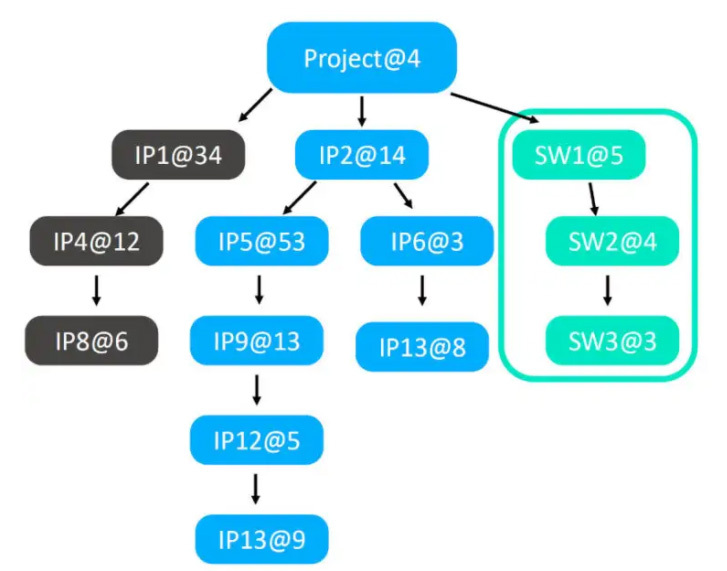Blog
June 30, 2021
When developing complex electronic products, many organizations divide their projects between hardware and software teams working in parallel. This is because these engineering teams have distinct methodologies for how they design, document, and communicate their changes. This approach, however, can lead to costly issues if teams are not aligned. And this is where a system-level bill of materials (system BoM) is critical for bringing hardware and software teams together.
In this blog, we discuss the importance of a system BoM in providing centralized design management with full traceability plus IP and component security.
What Is a System BoM?
A system BoM is a bill of materials that lists the versioned hierarchy of all IP (hardware) and components (software) used to define a system.
A sample illustration of a bill of materials can be seen below. The software blocks are displayed in green, along with their version numbers. The hardware blocks, displayed in blue and black, have their own hierarchies and version numbers.

Back to top
Why is a System BoM Important?
A unified, system-level view of a project as a whole is important in bringing hardware and software teams together. When working in parallel, it is very easy for hardware and software to get out of sync. Certain versions of software can quickly become incompatible with certain versions of hardware, and vice-versa.
📝Get a Free, Step-by-Step Guide to Creating a Dynamic BoM 📝
Our Planning in Perforce IPLM (formerly Helix IPLM) white paper has all the info you need to align your teams, streamline project planning workflows, and enable better build-or-buy decisions. You'll learn how industry leaders approach planning in our tool.
Without having a system-level view, you may (after you release a product) assume that a software change to a platform of products will work universally. In the meantime, there may have been tweaks to families of products in the hardware platform it needs to run on that make the software no longer compatible across the entire platform.
This is a problem that many organizations run into when they issue a software patch for a platform of products. A software fix could end up breaking some hardware, as the fix is not universal to the whole platform because of underlying changes that have been made to individual hardware. We discuss this in greater detail in our blog Why Is Traceability Important?
Without having a system-level view of the world, and understanding the configuration dependencies, it is very easy to make these mistakes and find them out after the fact. This is why you need this global view to get a handle on these changes.
Critical to this system-level view is metadata. Metadata includes dependencies, file permissions, design hierarchy, instance properties, and usage for each IP or component (both hardware and software). This robust data on each IP enables traceability for which software applies to which hardware. This helps to maintain consistency during the design process and find incompatibilities early. Additionally, tracking updates and patches across both software and hardware safeguards against mismatches creeping into the system during the design process.
Back to topCreating a Unified System BOM in Perforce IPLM
If your project only involves a handful of software and hardware blocks, then you can probably get by with a simple spreadsheet to track dependencies, versions, and usage. However, system design can involve thousands of hardware IPs and millions of lines of code. As complexity increases, having a unified system BOM with full traceability makes the process easier.
Perforce IPLM has been used by hardware teams for years now and provides those teams with a traceable platform that simplifies managing all of the IP that makes up a semiconductor design. The good news is that the Perforce IPLM platform can also be used in the software development world. Metadata can be tracked with software component versions in the same way that hardware teams have been tracking the lifecycle of their IPs.
By bringing software and hardware together, a single, holistic system BOM can be created. Configuration and release management can be extended to the system level. Not only can both hardware and software teams benefit from the traceability provided by the platform, but now a single system-level view of the BOM can be created, extending the capabilities to the entire development team.
Talk with one of our IP experts today to learn more about how Perforce IPLM can align your hardware and software teams to accelerate delivery and reduce costly mistakes with a system-level view of their design.
Learn more about Perforce IPLM
Related Reading
Explore additional semiconductor topics:

